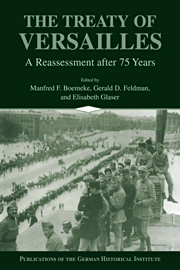Book contents
- Frontmatter
- Introduction
- Prologue: 1919-1945-1989
- PART ONE PEACE PLANNING AND THE ACTUALITIES OF THE ARMISTICE
- 1 Germany's Peace Aims and the Domestic and International Constraints
- 2 “Had We Known How Bad Things Were in Germany, We Might Have Got Stiffer Terms”: Great Britain and the German Armistice
- 3 French War Aims and Peace Planning
- 4 Wilsonian Concepts and International Realities at the End of the War
- 5 A Comment
- PART TWO THE PEACEMAKERS AND THEIR HOME FRONTS
- PART THREE THE RECONSTRUCTION OF EUROPE AND THE SETTLEMENT OF ACCOUNTS
- PART FOUR THE LEGACY AND CONSEQUENCES OF VERSAILLES
- PART FIVE ANTECEDENTS AND AFTERMATHS REFLECTIONS ON THE WAR-GUILT QUESTION AND THE SETTLEMENT
- Bibliography
- Index
3 - French War Aims and Peace Planning
from PART ONE - PEACE PLANNING AND THE ACTUALITIES OF THE ARMISTICE
Published online by Cambridge University Press: 05 January 2013
- Frontmatter
- Introduction
- Prologue: 1919-1945-1989
- PART ONE PEACE PLANNING AND THE ACTUALITIES OF THE ARMISTICE
- 1 Germany's Peace Aims and the Domestic and International Constraints
- 2 “Had We Known How Bad Things Were in Germany, We Might Have Got Stiffer Terms”: Great Britain and the German Armistice
- 3 French War Aims and Peace Planning
- 4 Wilsonian Concepts and International Realities at the End of the War
- 5 A Comment
- PART TWO THE PEACEMAKERS AND THEIR HOME FRONTS
- PART THREE THE RECONSTRUCTION OF EUROPE AND THE SETTLEMENT OF ACCOUNTS
- PART FOUR THE LEGACY AND CONSEQUENCES OF VERSAILLES
- PART FIVE ANTECEDENTS AND AFTERMATHS REFLECTIONS ON THE WAR-GUILT QUESTION AND THE SETTLEMENT
- Bibliography
- Index
Summary
introduction
This chapter centers on the negotiating position that the French government of Georges Clemenceau disclosed to its allies between December 1918 and February 1919. Because it was a negotiating position, one should not take it at face value or assume that all its elements were advanced with equal conviction. Its fate in the crucial sessions of the peace conference is discussed elsewhere in this book. The purpose here is to explain the position, the reason it came into being, the concerns that shaped it, and the historiographical controversies that have revolved around it since the French archives were opened. Perhaps the best place to begin is with a survey of the historiography.
French policy at the peace conference was contentious from the outset and was denounced by interwar British and American memoirists ranging from John Maynard Keynes and Ray Stannard Baker to Harold Nicolson and David Lloyd George. It was defended by its authors, including Clemenceau himself, and most persuasively by Andre Tardieu. It then suffered a generation of neglect, although in the 1940s there was a riposte to Keynes from Etienne Mantoux, and Philip Mason Burnett and Etienne Weill-Raynal made major contributions to historical understanding of the dispute over reparations.
- Type
- Chapter
- Information
- The Treaty of VersaillesA Reassessment after 75 Years, pp. 87 - 110Publisher: Cambridge University PressPrint publication year: 1998
- 19
- Cited by

